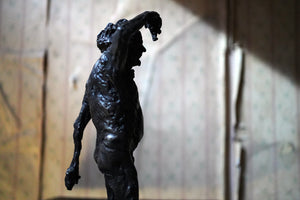Origin: Italian
Period: Late 18thC
Provenance: Unknown
Date: c.1780
Width: 7”
Height: 17.75
Depth: 8”
Exquisitely proportioned and detailed, and in unrestored condition, the terracotta, after the bronze chained captives by Pietro Tacca (c.1620-24), representing Barbary pirates chained and enslaved after naval victories over the Ottoman Turks, the study showing the captive bound and crafted as a grand tour memento and surviving from late eighteenth century Italy.
The condition of the piece is unrestored and there are losses to the base as photographed with two parts having been re-attached, losses to fingers and a hairline to one leg. Please refer to the photographs for a full visual reference. There is discoloration and wear but the overall tone and patina is very pleasing to the eye.
Pietro Tacca (16 September 1577 – 26 October 1640) was an Italian sculptor, who was the chief pupil and follower of Giambologna. Tacca began in a Mannerist style and worked in the Baroque style during his maturity.
Tacca's public works for the Medici include his masterpieces, the "Monument of the Four Moors", representing captured Barbary corsairs or Ottoman pirates (1620–24) at the foot of Giovanni Bandini's statue of Ferdinand I de' Medici, Reduced scale bronze adaptations were made by Foggini and these were to be the basis of reproductions for connoisseurs into the 18th century. Ceramic versions were made by Doccia (which is possibly who crafted this example) and other manufacturers.
Long before the days of Blackbeard and Anne Bonny, a very different type of pirate was wreaking havoc at sea. The Barbary pirates, or corsairs, were the outlaws of the waves before the golden age of piracy. From the 16th century onwards, these Muslim pirates operated out of the main ports along the North African coast – Algiers, Tunis, Rabat, Tripoli – raiding towns and seizing merchant ships primarily across the Mediterranean, although they did also venture into northern Europe and along the Atlantic coast of West Africa.
Their raison d’etre was to capture slaves for the Ottoman empire slave trade – although taking ownership of the valuable goods being transported across the Mediterranean was a gratefully welcomed by-product. The pirates didn’t discriminate about who they captured and placed in servitude. The make-up of those being forced into slavehood was a tangle of races, nationalities and religions. The pirates weren’t fussy, although Italian and Spanish slaves fetched a better price than northern Europeans.
The power and control enjoyed by the Barbary pirates for many decades wasn’t to last. Technology was a chief reason for their decline. Not only was their soldiers’ weaponry increasingly anachronistic, but the galleys couldn’t match – and would choose not to engage with – the growing military might of the big European navies. After a couple of anarchic, action-packed centuries, the Mediterranean became a comparatively safe sea once again.
A scarce and brilliantly executed piece of grand tour sculpture.
Period: Late 18thC
Provenance: Unknown
Date: c.1780
Width: 7”
Height: 17.75
Depth: 8”
Exquisitely proportioned and detailed, and in unrestored condition, the terracotta, after the bronze chained captives by Pietro Tacca (c.1620-24), representing Barbary pirates chained and enslaved after naval victories over the Ottoman Turks, the study showing the captive bound and crafted as a grand tour memento and surviving from late eighteenth century Italy.
The condition of the piece is unrestored and there are losses to the base as photographed with two parts having been re-attached, losses to fingers and a hairline to one leg. Please refer to the photographs for a full visual reference. There is discoloration and wear but the overall tone and patina is very pleasing to the eye.
Pietro Tacca (16 September 1577 – 26 October 1640) was an Italian sculptor, who was the chief pupil and follower of Giambologna. Tacca began in a Mannerist style and worked in the Baroque style during his maturity.
Tacca's public works for the Medici include his masterpieces, the "Monument of the Four Moors", representing captured Barbary corsairs or Ottoman pirates (1620–24) at the foot of Giovanni Bandini's statue of Ferdinand I de' Medici, Reduced scale bronze adaptations were made by Foggini and these were to be the basis of reproductions for connoisseurs into the 18th century. Ceramic versions were made by Doccia (which is possibly who crafted this example) and other manufacturers.
Long before the days of Blackbeard and Anne Bonny, a very different type of pirate was wreaking havoc at sea. The Barbary pirates, or corsairs, were the outlaws of the waves before the golden age of piracy. From the 16th century onwards, these Muslim pirates operated out of the main ports along the North African coast – Algiers, Tunis, Rabat, Tripoli – raiding towns and seizing merchant ships primarily across the Mediterranean, although they did also venture into northern Europe and along the Atlantic coast of West Africa.
Their raison d’etre was to capture slaves for the Ottoman empire slave trade – although taking ownership of the valuable goods being transported across the Mediterranean was a gratefully welcomed by-product. The pirates didn’t discriminate about who they captured and placed in servitude. The make-up of those being forced into slavehood was a tangle of races, nationalities and religions. The pirates weren’t fussy, although Italian and Spanish slaves fetched a better price than northern Europeans.
The power and control enjoyed by the Barbary pirates for many decades wasn’t to last. Technology was a chief reason for their decline. Not only was their soldiers’ weaponry increasingly anachronistic, but the galleys couldn’t match – and would choose not to engage with – the growing military might of the big European navies. After a couple of anarchic, action-packed centuries, the Mediterranean became a comparatively safe sea once again.
A scarce and brilliantly executed piece of grand tour sculpture.































